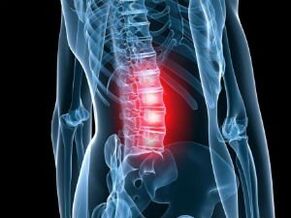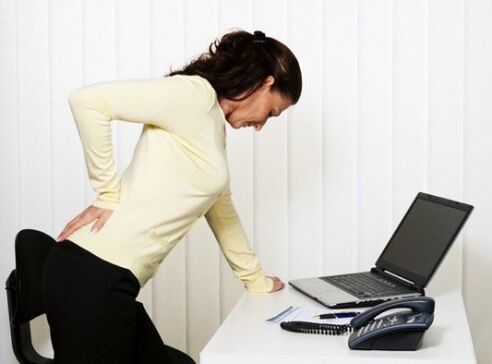
According to medical statistics, pain in the back of 80% of cases is caused by lumbar osteochondrosis.This happens as a result of degenerative-disstro changes in this segment when intervertebral discs and adjacent vertebrae are affected.Osteochondrosis of the lumbar spine (SPEP) is manifested by different symptoms: pain of different nature, limiting mobility, impaired sensitivity of the lower body, etc.With a long absence of treatment, degenerative processes are applied to the vertebrae, reducing the working capacity, then the patient can become damage.
To avoid dangerous complications of lumbar osteochondrosis (PO), you should start a complete treatment at 1-2 stages of pathology.In advanced cases, when irreversible changes in the disk or vertebrae are already present, surgery is performed.In order to avoid osteochondrosis of the lower back and related complications, it is necessary to perform its prevention.
The development of lumbar osteochondrosis
In order to find out what osteochondrosis is pop (lumbar spine), you need to study the structure of the spine.It consists of the vertebrae, between which are placed cartilage seals (intervertebral discs).The disc is covered with a hard fibrous membrane (fibrous ring), inside which there is a pulpal nucleus.This structure performs a shock absorption function, makes the spine be fascinating.
Reference.The lumbar segment of the spine is subjected to a huge load as it withstands the weight of the upper body.Therefore, osteochondrosis of the lower spine is diagnosed more often by the cervix, breasts.
With regular loads of the spine, the discs are compressed, many fluids are lost, their height is reduced and the distance between the vertebrae decreases.The cartilage seal becomes fragile, on its surface there are micro -cracks through which the pulp nucleus protrudes over time.With the further compression of the intervertebral discs, the outer membrane appears and the loss of the gelatin body, the hernia is formed.Then the pathological mobility of the vertebrae occurs, the load of the adjacent segments of the spine increases.
Little later, bone growths (osteophytes) begin to form at the ends of the vertebrae bodies.In this way, the body tries to stabilize the spine.
Doctors distinguish 4 stages of osteochondrosis of the lumbar spine:
- 1 degree - problems with the discs begin, the central part is dehydrated, it is flattened, cracks appear on the outer shell.There is a stuck.
- 2 degrees - Sealing of cartilage seals, the vertebrae approach each other, become more mobile, muscles and connections around the sagging of the spine.Pain occurs.
- 3 degrees - convexity, hernia, subluxation of the vertebrae are formed.The pain is increased, mobility is limited, the sensitivity of the lower body is impaired.
- Grade 4 osteochondrosis is characterized by the appearance of osteophytes, which can damage the spinal nerves, adjacent vertebrae.There is constant pain, pronounced neurological disorders and other complications, the risk of damage is increased.
It is easiest to cure lumbar chondrosis (stage 1), but it is very difficult to detect the disease at this stage.The interior osteochondrosis of 2 grade osteochondrosis is treated using conservative methods.Surgery may be required at 3-4 stages.
Reference.According to statistics, SPP is found more frequent in patients after 30 years.After 20 years, there are frequent cases of pathology in humans.Approximately 80% of patients from 60 years suffer from the manifestations of this disease.
Reasons
To find out how to deal with PKOP osteochondrosis (lumbosacral spine), you need to know its reasons:
- Regular static or dynamic load on the lumbar segment.The risk group for the development of osteochondrosis includes office workers, professional athletes (heavy athletics), wallets, builders and more.
- Standing, prolonged stay in the wrong posture.
- Genetic predisposition, abnormalities of vertebral bodies.This category includes youth software - spinal curvature caused by vertebral bodies pathologies.
- Injuries to the spine.
- Hormonal imbalance, metabolic disorders, endocrine diseases that disrupt the metabolism in the lumbar segment.
- Changes associated with age in the body provoke disk wear.
- Bone tuberculosis, osteomyelitis (purulent inflammation of the bone tissue), ankylosing spondylitis (inflammation of the vertebrae and joints), rheumatoid arthritis, etc.
Often the disease causes several causes at once.
In addition, there are factors that cause the development of lumbar osteochondrosis:
- Excess body weight.
- Passive lifestyle, prolonged place.
- Regular use of harmful foods (fatty, fried food, pastry, midfield products, etc.).
- Lack of fluid, dehydration.
- Congenital disorders of the structure of the spine, for example, an additional vertebra.
- Wearing uncomfortable heels regularly.
- The period of the fetal bearing, then the load on the spine increases.
- A sharp abandonment of professional athletes or excessive sports in people who have previously been passive.
- Smoking, frequent and immodest use of alcohol.
There are many more factors that can start degenerative dystrophic processes in the lumbar spine.For example, flat legs, frequent hypothermia, frequent stress, sleep disorders, etc.

Symptoms
The symptoms of osteochondrosis of the lumbar spine are varied, they depend on the stage of pathology and localization of the affected area.
Doctors distinguish reflex syndromes and compression (a complex of symptoms) for SPP.The first occurs with irritation of the receptors of the outer membrane of the discs, connections, joint capsules and the latter - for compression of nerve packages, blood vessels, spinal cord.
There are such reflex syndromes of lumbar osteochondrosis:
- Lumbago.Lowering the lower back pain with a sharp movement or tension.In the least experience of moving the pain syndrome, the patient freezes in one posture.The muscles in the damaged area are highly tense, with palpation the painful sensations become more pronounced.These manifestations are related to the movement of the pulpulated nucleus in the outer sheath.
- Lumbalgia.Real pain develops for several hours or days.The discomfort is enhanced by movements, a change in body position.It weakens when a person takes a horizontal posture with a roller under the lower back.When you raise a straight leg in this position, the pain intensifies (a symptom of LASSA).The degree of muscle tension is less than in lumbar.Lower back mobility is limited.
- Sciatica.The painful sensations (acute or pain) spread from the lower back in the lower body.There is an increase in this characteristic during movements.The pain weakens when resting the back.The muscles on the affected area are tense, and the pain syndrome is expressed by palpation.
Symptoms in compression syndromes depend on which sections of the lumbar segment are damaged.The characteristic signs are related to the compression of cerebrospinal nerves with hernias, osteophytes, shifted vertebrae.This condition is called radiculopathy, in which pain is exacerbated by the shortest movement, the muscles of the lower back are tense and mobility is limited.
Clinical manifestations of compression syndromes depending on the damaged vertebrae of the lumbar segment:
- L1 - L3 - pain and tingling of the area of the lower back, the anterior and inner surfaces of the thigh, it is difficult for the patient to bend/to terminate the legs in the knee.
- L4 - Pain syndrome spreads to the front of the thigh, falling to the knee (back).Sensitivity is disturbed in the same area.
- L5 - The painful sensations are emitted in the ass, the outside of the thigh, falling at the front of the lower legs to the inside of the foot and thumb.In the same area, it feels numbness, it is difficult for the patient to bend the thumb.
- S1 - the differences in pain from the lower part of the back, the outer and posterior surface of the thigh, falls to the outside of the lower legs, legs.In these areas there is a tingling, the muscles of the lower legs are weakened, so the patient is difficult to stand on socks.
There is a risk of damage to several nerve beams at a time, such as L5, S1.If the hernia shifts back, then it can squeeze the spinal cord.
With the compression of the blood vessels in the lower back, the likelihood of weakening of the leg muscles, numbness of the lower limbs, a disorder of control of the urination process and the bowel moves increase.In men, erection is impaired in men, and in women, the main symptoms can be supplemented by inflammation of the ovaries or uterus.
Diagnostic measures
To diagnose SPP, the doctor examines the patient, performs palpation to determine the condition of the muscles and to identify the curvature of the spine.It is important to say a specialist in detail about his symptoms so that it is easier for him to make a diagnosis.
Instrumental studies will help detect intervertebral osteochondrosis:
- Lower back rail (direct back and side projection).
- Calculated and magnetic tomography for refusal.
X -ray allows you to evaluate the structure of POP.In order to identify the pathological mobility of the vertebrae, the X is performed in the position of bending and lengthening.This study allows us to notice that the intervertebral gap has narrowed, the bodies of the vertebrae have shifted, the osteophytes appear at their edges.However, this diagnostic method is considered outdated.
Today, CT and MRI are increasingly used to detect degenerative dystrophic changes in the spine.These highly informative studies allow you to evaluate the condition of the vertebrae, discs, intervertebral holes, spinal cord.With their help, convexity, the direction of hernia reveal the degree of compression of the nerve rays, the spinal cord, the blood vessels.
Treatment
Lumbar osteochondrosis drugs

The treatment of osteochondrosis POP lasts from 1-3 months to 1 year.The success of therapy depends on the patient himself, who should closely monitor the doctor's recommendations.With suicide, the patient's condition usually worsens.
Therapy therapies:
- Stop or weaken the symptoms of the software.
- To identify the cause of the disease, try to exclude it from life.
- Eliminate the inflammatory process.
- Recovery of blood circulation, metabolic processes in the lumbar region.
- Try to improve the condition of the damaged cartilage seals, stop the larger degenerative changes.
In order to achieve such goals, it is recommended to perform complex therapy.Usually starts with drug use:
- Mussorelaxants.They relax the muscles, weaken pain and inflammation.
- Nsaid.They have anti -inflammatory, analgesic, antipyretic effects.
- Antispasmodics.They help to stop the spasm of the smooth muscles, to weaken the pain.
- Anesthetic agents.They are used for severe pain in the form of a therapeutic blockade.
- Glucocorticosteroids.They also help to deal with the pain.However, these funds are able to destroy the bones, so they take them for a short time and only after the doctor's approval.
- Caltives.Remove neuromuscular tension, improve sleep.
- Vitamins (Group B, E, C, a).Recover the condition of the affected nerves, weaken the pain.
Carefully.NSAIDs are forbidden to take gastritis or gastric ulcer, as they further damage the mucous membranes of the gastrointestinal tract.
With exacerbation, the patient is injected with injections and after stopping the main symptoms he takes oral agents.
In addition, external products (gels, ointments, cream, garbage) are used.
The question of what to do with chronic osteochondrosis of the lower back is quite up -to -date.If the SPP has become chronic, then after the main symptoms are the patient, the patient is prescribed chondroprotectors, medicines that restore blood circulation, medicines based on vitamins B. They help to restore the interior, normalize blood supply to the affected area and prevent the pathology.
The treatment of chondrosis of the lumbar spine (stage 1) is performed with the help of chondroprotectors that slow down the development of degenerative processes, accelerate cartilage regeneration.In addition, the patient is prescribed vitamin-mineral complexes.This form of osteochondrosis is easier to treat.
Other conservative methods
With Okz (osteochondrosis) 1 - 2 degrees, the following treatment procedures will help to stop its development:
- Ultrasound therapy weakens pain and inflammation, normalizes blood flow to the damaged area.
- Dutenzor therapy is a safe grip on the spine due to the weight of your own body, after which muscle tone normalizes, mobility improves.
- Magnetotherapy reduces the pain and inflammation of the muscles around the spine.
- Reflexology (the introduction of needles into bioactive points of the body) accelerates blood circulation, relieves inflammation and swelling.
- Manual therapy (exposure to the affected area with the hands of a doctor) and the massage normalize muscle tone, reduce the compression of the nerve rays, improve the strength of the intervertebral discs and restore the structure of the spine.
- Electrophoresis allows you to supply healing solutions through the skin of the bones and cartilage.
- Dragonalization improves blood circulation, metabolic processes, reduces pain, restores skin sensitivity.
There are still many effective procedures that will help improve the patient's condition in 5-15 sessions.The main thing is to get a doctor's approval before their behavior.
Home treatment at home
If you are interested in whether it is possible to treat OPP at home, then consult a doctor.If the specialist has given permission, start therapy, which usually consists of the following points:
- Diet.If lumbar osteochondrosis is caused by impaired blood flow or metabolism, then exclude fat, fried, spicy foods, eggs and more.From the menu, fill the menu with fresh vegetables, fruits, low fat, fish, acidic meat.Refuse alcohol, tonic drinks (tea, coffee).Drink filtered water, compotes, herbal teas.
- To restore blood circulation, exercise boot or use rubbing and compresses.
- He sleeps on an orthopedic mattress, low pillow.If you have a stuck work, then buy a chair with your back that will support the spine.Wear special corsets or belts from time to time.
- Exercise therapy will help to strengthen the muscle corset, remove some of the load from a diseased spine.The complex for each patient individually constitutes a doctor or instructor.
- Do a self -massage of the lumbar region.However, find out how to do it right with a professional.
- Use folk remedies in the form of friction, compresses, baths, etc.
- Acupuncture is a plastic plate with many spikes that improves blood circulation, metabolic processes in the damaged area, reduces muscle pain, relaxes.

And at home you can use lotions with herbal potions, plasters.
Reference.The novelty in the treatment of osteochondrosis is a massage bed, which is suitable even for the most unorganized patients.
Remember, however, that you can only be treated at home after your doctor's permission.
Surgical treatment
Lumbar osteochondrosis surgery is prescribed if conservative methods have been ineffective for a long time.And also surgery is shown with involuntary urination, defecation and tail syndrome (pinching of the nerves of the lower spinal cord).
Such surgical methods are used in the treatment of SPP:
- Spondylodeza - merging of adjacent vertebrae.
- Facetectomy - Removal of intervertebral joints that disrupt the cerebrospinal nerve.
- Laminectomy - removal of the plate covering the spinal canal that squeezes the spinal cord.
- Discoctomy is a complete or partial removal of the intervertebral disc, which causes compression of the nerve or spinal cord.
- Ceptectomy - Removal of the vertebral body and adjacent cartilage seals.Then the empty place is filled with bone transplantation and 3 spinal segments are consumed.
Reference.After surgery, there is a risk of complications: spinal cord trauma, nerve rays, transplant breakdown, infection, etc.
After treatment, it is necessary to undergo rehabilitation in order to accelerate recovery.
Complications
In the absence of competent therapy, the risk of such complications from lumbar osteochondrosis increases:
- Disc herniation, pinching of the nerve root or spinal cord.
- Long -term inflammatory processes increase the likelihood of radiculitis (inflammation of the nerve roots).
- Ishies (inflammatory damage to the sciatic nerve), in which severe pain and numbness of the lower limb occur.
- In the case of impaired blood circulation of the spinal cord, the likelihood of compression myelopathy increases (compression of the spinal cord with different entities: bone fragments, hernia, tumors, hematoma).
- Horse tail syndrome is compression of the roots of the lower spinal cord, leading to impaired bowel functionality, pelvic organs and lower limbs.
To avoid such complications, you should start treatment as early as possible.
Prevention
To avoid lumbar osteochondrosis, follow the following rules:
- You have a moderately active lifestyle (walk more often, exercise regularly, sign up for the pool).
- When sitting, heat every 1.5 hours.
- He sleeps on the orthopedic mattress.
- Avoid excessive exercise, lift the weight only from the position of the semi -crime, before place a special belt on the lower back.
- Buy orthopedic shoes.
- Eat properly, take vitamin-mineral complexes as prescribed by a doctor.
- Learn to relax.
- Try not to hypothermia.
- Over time, healing diseases that can cause SPP.
- Give up bad habits.
By following these recommendations, you can avoid degenerative changes in the spine and improve your health.
The most important thing
If you notice the symptoms of lumbar osteochondrosis, then see an urgent doctor.Independent treatment can worsen your condition and cause complications.Lumbar chondrosis (1st stage) is treated with exercise, physiotherapy and chondroprotectors.In the short stages, medicines, massage, manual therapy and more are used.In the absence of positive dynamics for a long time or the onset of neurological symptoms, the doctor may prescribe surgery.The patient should strictly follow the doctor's recommendations to speed up recovery.



































